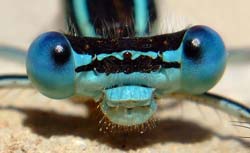New International Research Initiative on the Evolution of Insects officially started

The evolution of damselflies (here a Coenagrion male) is of interest. Foto: Johannes Dambach, ZFMK<br>
It will unravel the secrets of the evolutionary history of insects using a molecular data set of unparalleled dimensions and quality. Started in September 2011, the transcriptomes of 1,000 insect species will be investigated. Within the next two years, BGI, China – the world’s largest genomic sequencing center – has invested initiating funds to enable this international project that requires roughly 6 Million dollars and has made its extensive sequencing infrastructure available to achieve this goal.
The realization of this ambitious program requires synergistic collaboration among experts from a wide range of research fields. The 1KITE has brought together around 50 internationally renowned experts in molecular biology, morphology, palaeontology, embryology, bioinformatics, and scientific computing in an unprecedented way. Overall, scientists from seven nations (Australia, Austria, China, Germany, Japan, Mexico, and the US) are tightly collaborating in the 1KITE project.
A “transcriptome” includes the sequences of all the sets of genes that are being “translated ” into proteins in a particular organism at the time it was collected. It represents a major and important part of the complete genome, since these mRNAs are involved in the life processes of the organism and how it interacts with it's ecosystem. Analyses of the transcriptome data will allow the reconstruction of a robust phylogenetic tree of insects, which will greatly contribute to the understanding of the reasons for their astonishing success. Furthermore, the project includes the development of new and advanced approaches analyzing enormous (“phylogenomic”) data sets, which are generated by new laboratory techniques at an ever-increasing rate. “These data will produce the best resolved tree of insects, setting the stage for comparative analyses of genome evolution” says Prof. Bernhard Misof, Head of the Department of Molecular Biodiversity Research at the ZFMK, Bonn, Germany. Professor Misof is one of the initiators of this research program, along with Karl Kjer from Rutgers University, and Xin Zhou from BGI.
Insects are the most species-rich group of animals. They play a pivotal role in most non-marine ecosystems and many insect species are of enormous economic and medical importance as pests, pollinators, disease vectors, and keystone species. “It will be essential to resolve the relationships within insects in order to understand how such an immense diversity of insects could have evolved. Since insects are such an fundamental component of biodiversity we hope to answer why ecosystems shaped and adjusted in the way they are” says Dr. Xin Zhou, Head of the National Bio-resource Bank at BGI and co-founder of the 1KITE project.
Part of the project is devoted to the development of new bioinformatics methods. “The production of new data has gained such an enormous speed recently, that the analysis and storage of the data will become the real challenge in the near future!” says Dr. Alexandros Stamatakis, Head of the High Performance Computing Department at HITS, Heidelberg.
Involved are:
• From Japan: the Sugadaira Mountain Research Center; Department of Arthropod Comparative Embryology, University of Tsukuba; and the Department of Systematic Entomology, Hokkaido University.
• From Austria: the Department of Evolutionary Biology and the Department of Animal Biodiversity, University Vienna and the Natural History Museum, Vienna.
• From the US: the Department of Ecology, Evolution and Natural Resources and the Department of Biological Sciences, Rutgers University; the Department of Entomology, North Carolina State University; and Department of Entomology, University of Minnesota.
• From Australia: the CSIRO Ecosystem Sciences, Australian National Insect Collection, Canberra.
• From Mexico: the Centro de Estudios en Zoologí, Universidad de Guadalajara, Zapopan, Jalisco.
• From China: BGI and China Agricultural University, China Agricultural University, Department of Entomology, Laboratory of Systematic & Evolutionary Entomology, Bejing, China
• From Germany: Zoological Research Museum Koenig, the Institute of Systematic Zoology and Evolutionary Biology with Phyletic Museum Jena, the Department of Scientific Computing at the Heidelberg Institute for Theoretical Studies, the Zoological Institute and the Zoological Museum, University of Hamburg, the Department of Paleontology, Steinmann Institute, University of Bonn, and the Stuttgart State Museum of Natural History.
• From New Zealand: the Department of Biosystematics, Landcare Research, Auckland.
The Zoological Research Museum Alexander Koenig (ZFMK) and Leibniz Institute for Animal Biodiversity is one of the largest natural-history-research museums in Germany. The museum has earned its reputation as a leader in the documentation, research, and interpretation of biodiversity.
The Leibniz Association is a network of 87 scientifically, legally and economically independent research institutes and scientific service facilities. Leibniz Institutes perform strategic- and thematically-oriented research and offer scientific service of national significance while striving to find scientific solutions for major social challenges.
Media Contact
More Information:
http://www.1kite.org/All latest news from the category: Life Sciences and Chemistry
Articles and reports from the Life Sciences and chemistry area deal with applied and basic research into modern biology, chemistry and human medicine.
Valuable information can be found on a range of life sciences fields including bacteriology, biochemistry, bionics, bioinformatics, biophysics, biotechnology, genetics, geobotany, human biology, marine biology, microbiology, molecular biology, cellular biology, zoology, bioinorganic chemistry, microchemistry and environmental chemistry.
Newest articles

Security vulnerability in browser interface
… allows computer access via graphics card. Researchers at Graz University of Technology were successful with three different side-channel attacks on graphics cards via the WebGPU browser interface. The attacks…

A closer look at mechanochemistry
Ferdi Schüth and his team at the Max Planck Institut für Kohlenforschung in Mülheim/Germany have been studying the phenomena of mechanochemistry for several years. But what actually happens at the…

Severe Vulnerabilities Discovered in Software to Protect Internet Routing
A research team from the National Research Center for Applied Cybersecurity ATHENE led by Prof. Dr. Haya Schulmann has uncovered 18 vulnerabilities in crucial software components of Resource Public Key…





















